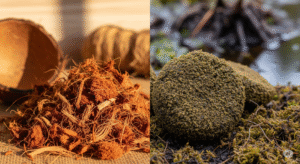1. Introduction: A Green Revolution from the Coconut Husk
In an era where climate-smart agriculture is more necessity than novelty, an unlikely hero is emerging from beneath the husk of a coconut. Meet cocopeat – the fibrous, sponge-like byproduct of coconut processing that’s rewriting the rulebook on sustainable horticulture.
Once discarded as waste, cocopeat has found a second life as a high-performance growing medium. Its ability to retain water, support root health, and reduce environmental impact is turning heads from commercial greenhouses in the Netherlands to rooftop gardens in Mumbai. As traditional substrates like peat moss come under scrutiny for their ecological footprint, cocopeat is stepping in—not as a trend, but as a quietly disruptive force in modern agriculture.
2. What is Cocopeat?
Cocopeat, also known as coir pith or coconut coir, is a natural byproduct of coconut husk processing. It is the fibrous, spongy material found between the outer husk and the hard inner shell of a coconut.
During the fiber extraction process, this material is separated, washed to remove salts, dried, and then compressed into various forms such as blocks, briquettes, or loose fill. These forms are commonly used in gardening and horticulture.
Cocopeat is valued for its lightweight texture, high water retention, and good aeration properties, making it a widely used growing medium in both home gardening and commercial agriculture. It serves as an alternative to peat moss and traditional soil-based media, particularly in hydroponics, seed germination, and container cultivation.
3. Why Cocopeat is Transforming Horticulture
Cocopeat has gained widespread attention in horticulture due to its practical advantages as a growing medium. Its physical and chemical properties address common challenges in plant cultivation, making it suitable for a range of growing environments and systems.
a. Water Retention and Aeration
Cocopeat can retain up to 8–10 times its weight in water, helping to maintain consistent moisture levels in the root zone. This reduces the frequency of irrigation, which is particularly useful in regions with limited water availability or in hydroponic systems. Its porous structure allows for adequate air circulation around roots, helping to reduce the risk of compaction and improving root health.
b. pH and Nutrient Characteristics
With a natural pH range of 5.5 to 6.8, cocopeat is generally suitable for a wide variety of plants without requiring significant pH adjustment. Additionally, it has a moderate cation exchange capacity (CEC), which enables it to retain and release nutrients effectively. This can improve nutrient efficiency and reduce leaching.
c. Environmental Sustainability
Cocopeat is derived from coconut husks, a byproduct of the coconut industry. Using it as a growing medium contributes to waste reduction and decreases reliance on non-renewable substrates such as peat moss, which is extracted from fragile ecosystems. It is also biodegradable and can be reused or composted after use, aligning with sustainable agricultural practices.
d. Resistance to Soil-Borne Diseases
Cocopeat has some natural antifungal properties, which may help reduce the occurrence of certain soil-borne pathogens. While not a complete substitute for disease management, it can support efforts to lower chemical inputs in organic or low-input farming systems.
e. Versatility in Application
Cocopeat is used across a variety of growing methods, including seed starting, container gardening, hydroponics, greenhouse cultivation, and soil conditioning. It can be used alone or combined with other media like perlite or vermiculite to modify texture, aeration, or drainage according to crop needs.
4. Global Market & Adoption
Cocopeat has seen increasing adoption worldwide as growers seek sustainable alternatives to conventional substrates like peat moss and soil. Its performance in water retention, aeration, and versatility has made it a viable option across various agricultural systems.
Market Growth and Trends
As of 2023, the global cocopeat market was valued at approximately USD 600 million, with estimated annual growth rates exceeding 10%. This growth is largely driven by increased interest in sustainable agriculture, urban farming, and water-efficient cultivation methods.
Geographical Adoption
Europe: Countries such as the Netherlands, Germany, and the United Kingdom are among the leading adopters, especially in commercial horticulture and greenhouse-based vegetable production.
North America: Usage is growing steadily in the United States and Canada, particularly among organic farmers, home gardeners, and hydroponic operations.
Asia-Pacific: In countries like India, Sri Lanka, Indonesia, and Thailand, cocopeat is both produced and widely used. These regions are also major exporters, supplying processed cocopeat to international markets.
Key Drivers
Water conservation: Cocopeat’s ability to retain moisture makes it particularly valuable in arid and semi-arid regions.
Urban agriculture: Its light weight and cleanliness make it suitable for rooftop and indoor gardening.
Export potential: Countries with abundant coconut production are expanding cocopeat processing as part of agro-export strategies.
5. Practical Usage Tips
While cocopeat offers many advantages, proper handling and application are essential to achieve the best results. Here are key considerations for using cocopeat effectively in horticultural and gardening settings:
a. Don’t Use Cocopeat Alone for All Crops
Although cocopeat retains moisture well, using it on its own can lead to excessive water retention, which may cause root suffocation in some plants. It’s generally recommended to mix cocopeat with materials like perlite, vermiculite, or coarse sand to improve drainage and balance air-to-water ratios, especially for crops sensitive to waterlogged conditions.
b. Pre-Washing and Buffering
Raw or low-quality cocopeat may contain excess salts. Before use:
-
Soak and rinse thoroughly with clean water to remove residual salts.
-
For sensitive crops, buffering with calcium nitrate may be needed to displace sodium and potassium ions.
Many commercial products come pre-washed and buffered, but it’s good practice to check product labeling or perform a conductivity test (EC level).
c. Reuse and Reconditioning
Cocopeat is reusable across multiple growing cycles:
-
After harvesting, remove plant debris and roots.
-
Wash thoroughly and allow it to dry.
-
Recondition with nutrients or compost before reuse, depending on the crop.
Note: Structure may degrade slightly over time, so it’s better suited for reuse in potting mixes or compost after 2–3 cycles.
d. Storage and Handling
-
Store in a dry place to prevent mold or fungal contamination.
-
Keep compressed bricks or blocks in sealed packaging until ready for use.
-
When expanding cocopeat with water, use clean, chlorine-free water for optimal results.
6. Conclusion: A Medium with Long-Term Potential
Cocopeat has emerged as a practical, sustainable growing medium suited to a range of horticultural systems. Its water retention, aeration, pH balance, and reusability make it a strong alternative to conventional substrates like soil and peat moss.
As global agriculture faces increasing pressure to reduce water use, lower chemical inputs, and adopt circular practices, cocopeat offers a viable solution supported by both performance and environmental value. From small-scale urban gardens to commercial hydroponic farms, its flexibility continues to drive widespread adoption.
Growers looking to balance productivity with sustainability may find cocopeat to be not just an option but a step toward more efficient and responsible cultivation.
Frequently Asked Questions (FAQ)
1. What is cocopeat used for in gardening?
Cocopeat is widely used as a soil substitute or soil conditioner in gardening. It supports seed germination, potting mixes, hydroponic systems, and terrace gardens due to its excellent water retention and aeration properties.
2. Is cocopeat good for all types of plants?
Yes, cocopeat is suitable for most indoor and outdoor plants, including vegetables, herbs, flowers, and ornamentals. Its neutral pH and sterile, pest-free nature make it safe for a wide range of crops when used alone or in combination with other substrates.
How do you prepare cocopeat for planting?
To prepare cocopeat:
- Soak the compressed brick/block in clean water until fully expanded.
- Rinse thoroughly to remove excess salts.
- Optionally mix with perlite, compost, or vermicompost for added drainage and nutrition.
4. Can cocopeat replace soil completely?
In hydroponics and soilless gardening, cocopeat can serve as a full growing medium. However, for traditional cultivation, it is best used in combination with other materials to provide adequate nutrients, as cocopeat itself is low in nutrients.
5. Where can I buy cocopeat for gardening?
Cocopeat is available at garden centers, agriculture supply stores, and online platforms like Amazon, Flipkart, and specialty gardening sites. It comes in forms like compressed bricks, loose-fill bags, or discs for seed trays.


